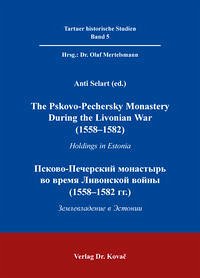During the Livonian War (1558–1582) a major part of medieval Livonia (modern Estonia and Latvia) was conquered by Ivan the Terrible’s Russia, and Muscovian administration was introduced in the annexed territories. A Russian Orthodox Church organisation was also established in the territory of medieval Livonia for the Russians who had migrated during the war. A unique source of this matter is the land charter of the Pskovo-Pechersky Monastery issued in 1563. It contains data about the settlement, economy, administration, and social history of Estonian and Pskov lands in the 16th century, including also rich onomastic material, being in fact the oldest surviving fragment of land cadastres of the area. The document includes unique historical material about Setumaa, the distinct frontier region between Estonia and Russia. The charter also provides information about the history of the monastery, the impact of warfare on the civilian population, and some insights into the history of pre-war medieval Livonia. The source publication is accompanied by extensive general commentary. Some of the toponyms and personal names have been identified to facilitate orientation. The indexes of place-names and personal names simultaneously serve as a concordance for the name forms in different languages. Weitere Schlagworte: Kirchengeschichte, historische Namenforschung, Setumaa, Siedlungsgeschichte
Bitte wählen Sie Ihr Anliegen aus.
Rechnungen
Retourenschein anfordern
Bestellstatus
Storno

